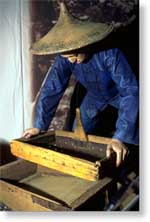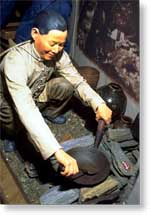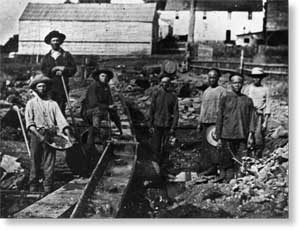 |
 |
||
|
Prospecting - Chinese Placer Mining I came upon a Chinese camp. About a hundred Chinamen had pitched their tents on a rocky eminence by the side of their diggings. When I passed they were at supper, and had all the curious pots and pans and other fixins which I had seen in every Chinese camp. - anon.
Anti-Chinese sentiment But things
changed quickly in the gold fields, and that open attitude didn't last long. The mines
soon became crowded and competition increased. Who became a target of all those frustrated
miners? Anyone who was a not American - especially if their ethnicity, language or customs
were easily identified as "different" than the Yankees. First it was the miners
from Mexico, Chile, and Peru. Then it was the Chinese. The Chinese were very efficient
miners. Because they managed to get gold out of claims which whites had abandoned as
unprofitable, their success was especially resented.
Chinese Camp | Arrastra | Miwok Mining Site | Coyote Hole | Long Tom |
|||
 This is a Chinese gold miners' camp. By 1852,
25,000 Chinese had come to what they called Gum Shan - "Gold Mountain," making
them the largest foreign group in the mining region at that time. Their sites were truly
camps, for they usually worked and lived in large communal groups.
This is a Chinese gold miners' camp. By 1852,
25,000 Chinese had come to what they called Gum Shan - "Gold Mountain," making
them the largest foreign group in the mining region at that time. Their sites were truly
camps, for they usually worked and lived in large communal groups. digging in the mines, but citizens said, let them come, there is
room for the world for generations!
digging in the mines, but citizens said, let them come, there is
room for the world for generations! They
were an easy mark for discriminatory taxes. By 1870, the Foreign Miners Tax was bringing
in nearly one-quarter of the State's revenue.
They
were an easy mark for discriminatory taxes. By 1870, the Foreign Miners Tax was bringing
in nearly one-quarter of the State's revenue.